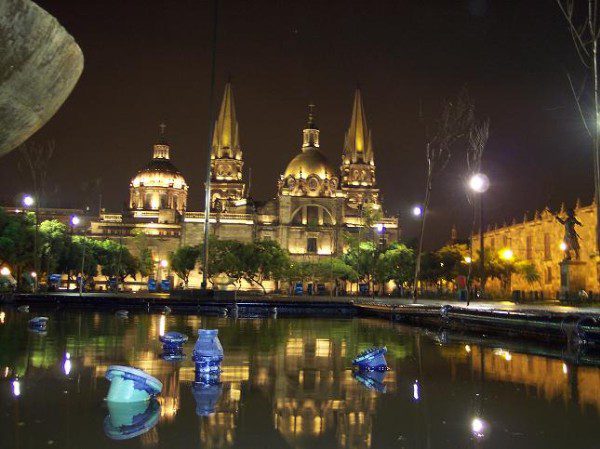
The Plaza de la Liberación and Cathedral in Guadalajara, Mexico
(Wikimedia Commons)
A rim of mountains runs along the western side of the peninsula. These mountains are cut by many valleys, each of which is known as a wadi (pronounced wah-dee), and many of these wadis serve as caravan routes.[1] Plains, usually narrow, are found along the coasts. Oases, where a spring furnishes enough water for at least some vegetation, are found especially along the caravan routes in northern Arabia. No large lakes exist in Arabia, and there is only one short river, in the south, that manages to flow more or less year round. On the other hand, after occasional cloudbursts, temporary freshets may rush down the valleys. But these torrents soon vanish, and they cannot serve as dependable sources of water to travellers. (See, for instance, Job 6:15-20, which refers to known locations in the Nufud desert and in the south of the peninsula). It was probably one of these “rivers of water” that Nephi saw as he and his family made their way down the coast of Arabia toward the land of promise.[2] Even the “filthy” river observed by Lehi and Nephi in their visions of the Tree of Life sounds like one of these torrents, hurtling down the valleys with a load of dirt and sand and rocks. Like flash floods in the deserts of western North America, these “rivers” would disappear as suddenly as they had appeared. So the people in the peninsula have had to be resourceful, and, since water sometimes remains in the subsoil of the wadis, the Arabians have learned to dig wells to find it.
It was not, however, only the Arabians who had to put up with the harsh climate of their land. Sometimes that climate visited surrounding lands. The east wind, for example, which came from the deserts to the south and southeast of Palestine, carried dry, dusty, hot air—to the immense discomfort of both men and animals. It blasted vegetation, as in Pharaoh’s dream of the seven thin ears of corn. It could become a tempest, destroying ships at sea. It was an east wind that drove back the waters of the Red Sea, permitting the children of Israel to pass over on dry ground. It was the east wind that brought Moses’ locust plague to Egypt and the prophet Joel’s plague to Palestine .[3]
So, again, why would anybody want to control so inhospitable a place as Arabia? The answer is that it was a crossroad of world trade. Whoever controlled it, controlled the trade. Oil had not yet assumed any importance, but there were many other commodities that moved across Arabian sands on their way to the wealthy cities of the eastern Mediterranean. “Almug trees,” to choose just one such commodity, were brought by the Arabian queen of Sheba to king Solomon and are commonly thought to have been red sandalwood, brought originally from India and Ceylon.[4] Ebony seems to have been imported by early Arabian merchants from Africa.[5] Dates and date palms, such as those found by the wandering children of Israel at Elim, were also an important part of the Arabian economy.[6] To this day, they are known as “bedouin bread.”
But the most important commercial products freighted across ancient Arabia were, beyond doubt, frankincense and other perfumes. Arabia and the Arabians are often associated with spices in the Bible. Thus, Joseph’s brothers, for instance, sold him to “a company of Ishmeelites,” who had come “from Gilead with their camels bearing spicery and balm and myrrh, going to carry it down to Egypt.”[7] And the queen of Sheba, visiting Solomon, “came to Jerusalem with a very great train, with camels that bare spices, and very much gold, and precious stones . . . And she gave the king an hundred and twenty talents of gold, and of spices very great store, and precious stones: there came no more such abundance of spices as these which the queen of Sheba gave to king Solomon.”[8] Even in prophecy, this is the image of Arabia: “The multitude of camels shall cover thee,” says Isaiah, “the dromedaries of Midian and Ephah; all they from Sheba shall come: they shall bring gold and incense; and they shall shew forth the praises of the Lord.”[9]
[1] The word wadi appears very commonly (as guada-) in Spanish place-names such as Guadalajara (wadi al-hajara, “valley of stones”), Guadalquivir (al-wadi al-kabir, “the big river”), and Guadalcanal. In the last case, the sixteenth-century Spanish discoverers of an island in the southwestern Pacific named it after a location near Seville that had originally been called wadi al-khanat (“the valley of stalls”) because of the refreshment stalls that had been set up there during the Muslim period. The very common place-name Guadalupe comes either from Arabic al-wadi al-lubin (“the hidden valley”) or from wadi combined with the Latin word lupe, meaning “wolf.”
[2] 1 Nephi 2:6-9, 16:12. See Hugh Nibley’s discussion in Lehi in the Desert/The World of the Jaredites/There Were Jaredites, Volume 5 in the Collected Works of Hugh Nibley (Salt Lake City and Provo: Deseret Book and the Foundation for Ancient Research and Mormon Studies, 1988), 79-83.
[3] On the east wind, see Genesis 41:6-7; Exodus 10:13; 14:21; Job 27:20-21; Psalm 48:7; Isaiah 27:8; Ezekiel 17:10; 27:26; Jonah 4:8. So powerful was the image of the east wind as an agent of destruction and divine wrath that the peoples of the Book of Mormon continued to use it, even if it was perhaps not strictly applicable to their different geographical situation: King Limhi quotes the Lord as saying, “If my people shall sow filthiness they shall reap the east wind, which bringeth immediate destruction” (Mosiah 7:31; compare 12:6).
[4] 1 Kings 10:11-12.
[5] See, for example, Ezekiel 27:15.
[6]Exodus 15:27
[7] Genesis 37:25.
[8] 1 Kings 10:2, 10; compare 2 Chronicles 9:1, 9. The queen’s visit to Solomon was almost certainly part of a trade mission.
[9] Isaiah 60:6.











